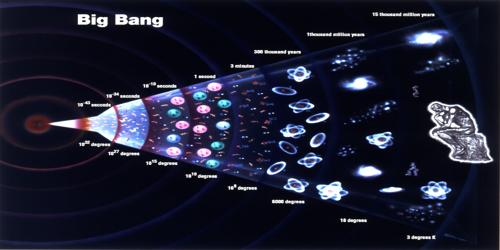Imagine peering into the heart of a cosmic time machine. You’re transported billions of years back, before the first stars ignited, before the first galaxies were formed. All you see is a blindingly hot and dense point, smaller than an atom. This is what scientists believe was the origin of our vast, magnificent universe – the Big Bang. It’s not just a theory; it’s a cornerstone of modern cosmology, a unifying narrative that explains the universe’s evolution from its fiery beginnings to the present day. In this article, we’ll embark on a journey through the Big Bang theory, understanding its concepts, its evidence, and its impact on our comprehension of the cosmos.

Image: anacetoz.vercel.app
The Big Bang theory is the prevailing cosmological model for the universe’s early existence and subsequent evolution. It posits that the universe began from an incredibly hot and dense state, and over time, it has expanded and cooled, eventually leading to the formation of stars, galaxies, and everything we see today. It’s not just a whimsical notion; it’s backed by a compelling collection of scientific observations and theoretical frameworks. But how did scientists arrive at this groundbreaking theory? Let’s take a look at the historical context.
The Universe in Motion: A Journey Through Time
The Big Bang theory didn’t spring into existence overnight. It was the culmination of centuries of astronomical observations and theoretical developments, each contributing to our understanding of the universe. The seeds of the theory were sown in the early 20th century with Albert Einstein’s groundbreaking theory of General Relativity. This revolutionary theory revolutionized our understanding of gravity, suggesting that it isn’t merely a force but a curvature in the fabric of spacetime. Einstein’s equations suggested a universe that was static – neither expanding nor contracting. However, observations by astronomer Edwin Hubble in the 1920s presented a different picture. He noted that distant galaxies are moving away from us, and the further away they are, the faster they’re moving. This phenomenon, known as Hubble’s Law, strongly hinted at an expanding universe, challenging the prevailing static model.
The Big Bang: A Moment of Creation
Further investigations into the cosmic microwave background radiation, a faint afterglow of the Big Bang, provided even stronger evidence for the theory. This radiation, discovered in 1964, is a faint hum of radiation that permeates the entire universe. Its existence was predicted by the Big Bang theory and provided strong support for the idea of a hot and dense early universe. As the universe expanded and cooled, the primordial plasma emitted radiation that has red-shifted over time and now exists as a faint background radiation. It’s a direct echo of the Big Bang, a cosmic fingerprint from the universe’s infancy.
The Cosmic Inflation: A Rapid Expansion
While the Big Bang theory elegantly explains the expanding universe, it faces a challenge when accounting for the homogeneity and flatness of the universe. The Big Bang alone wouldn’t be able to explain why the universe is so uniform and flat on large scales. To address this, the theory of cosmic inflation was proposed. It suggests that in the first fraction of a second after the Big Bang, the universe underwent a period of incredibly rapid expansion, inflating to vast proportions in a blink of an eye. Cosmic inflation explains the uniformity of the universe by stating that a small, initially uneven region expanded exponentially, smoothing out any initial irregularities. It also helps explain a relatively flat universe, making it a natural extension of the Big Bang model.

Image: qsstudy.com
The Birth of Stars and Galaxies: Cosmic Evolution
The Big Bang was not a violent explosion that hurled matter into space, but rather the expansion of space itself. As the universe continued to expand and cool, the primordial soup of particles began to coalesce, forming stars and galaxies. The first stars were massive and short-lived, eventually exhausting their fuel and exploding as supernovas. These explosions scattered elements heavier than hydrogen and helium into the surrounding space, providing the building blocks for future stars and planets.
The End of the Big Bang?
It’s important to understand that the Big Bang wasn’t a single event, but rather a continuous process. Although the initial expansion was incredibly rapid, the universe continues to expand, albeit at a slower rate. The Big Bang theory doesn’t predict the end of the universe, but various scenarios are possible. Some models suggest an eternal expansion, while others predict a “Big Crunch”, where the universe will eventually collapse back upon itself.
The Big Bang Beyond the Textbook: Exploring the Unknown
Despite its remarkable success, the Big Bang theory still leaves many questions unanswered. One of the most pressing is the nature of dark energy, a mysterious force that is accelerating the expansion of the universe. We don’t fully understand its origin or properties, creating a gap in our understanding of the universe’s future. Other mysteries include the nature of dark matter, an invisible form of matter that accounts for a significant portion of the universe’s mass. Its interaction with normal matter remains elusive, presenting a challenge to our current models.
Embracing the Big Bang: A Paradigm Shift in Perception
The Big Bang theory has revolutionized our understanding of the universe, from its birth to its evolution. It’s a testament to the power of observation, experimentation, and theoretical reasoning. However, it’s essential to acknowledge that science is a continuous pursuit of knowledge. The Big Bang theory is a work in progress, continuously refined and expanded with new discoveries and observations.
Summary Of The Big Bang Theory
A Call to Action: Embrace the Cosmic Journey
As we explore the universe’s grandeur, we’re not just learning about its origins, but also about ourselves. Our existence is interwoven with the cosmic tapestry, a testament to the intricate dance of stars, planets, and time. Embracing the Big Bang theory is not merely accepting a scientific model. It’s embracing a sense of wonder, realizing that we are part of a grand and ever-expanding universe, continually revealing its secrets to those who dare to seek them. So, let’s continue to explore, question, and learn, and as we do, we’ll delve deeper into the mysteries of the Big Bang and the wondrous universe it gave birth to.




